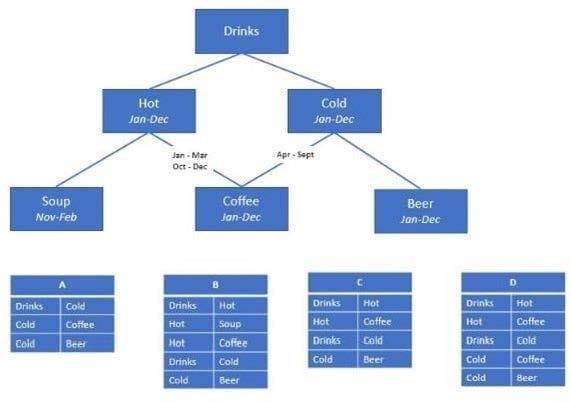C_HANAIMP_17 Online Practice Questions and Answers
You want to create a star schema using a calculation view. The measures are based on columns from two transaction tables. Dimension calculation views provide the attributes.
What is the correct approach?
A. Combine the transaction tables using a join node in a calculation view of type cube. Use the multi-join capability of the join node to connect the transactional tables with the dimension calculation views.
B. Combine the transaction tables using a star join node in a calculation view of type cube with star join. Use a join node to join the dimensions to the fact table.
C. Combine the transaction tables using an aggregation node in a calculation view of type cube with star join. Use a star join node to join the dimensions to the fact table.
D. Combine the transaction tables using a join node in a calculation view of type cube with star join. Use a star join node to join the dimensions to the fact table.
Which of the following techniques can you use to improve the performance of calculation views?
Note: There are 2 correct answers to this question.
A. Limit the number of stacked calculation views
B. Avoid aggregating data early in the dataflow
C. Implement union pruning
D. Partition large tables
Why do you use parameter mapping in a calculation view?
Note: There are 2 correct answers to this question.
A. To convert the data types of input parameters
B. To push down filters to the lowest level calculation views
C. To pass variable values to external value help views
D. To enable an input parameter in a calculation view
What can you extract using the standard text analysis configuration: Voice of the Customer? Note: There are 2 correct answers to this question.
A. Recommendations
B. Sentiments
C. Suggestions
D. Requests
How can you define a variable that presents its value help hierarchically?
Note: There are2 correct answers to this question.
A. Create a parent-child hierarchy and assign it to the variable. Ensure the variable's reference column is the parent attribute of the hierarchy.
B. Create a parent-child hierarchy and assign it to the variable. Ensure the variable's reference column is the child attribute of the hierarchy.
C. Create a level hierarchy and assign it to the variable. Ensure the variable's reference column is the leaf level of the hierarchy.
D. Create a level hierarchy and assign it to the variable. Ensure the variable's reference column is the top level of the hierarchy.
Why might you use SAP HANA Graph with text analysis?
A. To illustrate multi-point relationships between text entities
B. To provide a visual method to build a custom text analysis
C. To highlight similarities between documents using hierarchies
D. To uncover the dependencies between parts of speech
In text processing, where do you use the Term Document Matrix?
A. Text mining
B. Linguistic extraction
C. Fuzzy text search
D. Fact and entity extraction
What type of data is relevant for SAP HANA Graph modeling?
A. Highly-networked
B. Timeseries
C. Hierarchical data
D. Forecast
You created a table function to remove previous records, sum the current total weekly working hours for each employee, and updated the personnel table. The build of the table function fails. Which of the following could be a valid reason?
A. You did NOT define a valid table type.
B. Your function refers to a scalar function.
C. You did not define at least one input parameter.
D. Your function includes a TRUNCATE statement
In which of the following scenarios would you benefit from enabling table partitioning in SAP HANA?
A. You have a large row store table that is consumed in a view with a variable on COUNTRY column.
B. You have a large column store table that is consumed in a view with a variable on COUNTRY column.
C. You have a dedicated table lo generate the lists of help values for an input parameter.
D. Your stacked model consists of multiple calculation views.
Which type of join supports a temporal condition in a calculation view?
A. Left outer join
B. Text join
C. Referential join
D. Inner join
You are building a new calculation view B that uses calculation view A as a data source. In the Semantics node of calculation view A, you define a mask for the first 10 digits of a 15 digit Account Number. When you preview calculation view B, the Account Number is not masked.
Why do you see the Account Number unmasked?
A. The masking is based on the column of a row table.
B. You did not define masking in calculation view B.
C. The UNMASKED privilege for calculation view A has been granted.
D. The Account Number is based on the Integer datatype.
Which of the following results are generated when you query this temporal hierarchy using a time-validity period interval of March to May?

A. D
B. C
C. A
D. B
What is the disk storage layer used for?
Note: There are 2 correct answers to this question.
A. To unload the least-used data when the memory is full
B. To improve the parallel processing of queries
C. To store the data primarily used for transactional processing
D. To enable data to be recovered if hardware fails
You are a data analyst working with medical records that contain confidential patient information. Why do you use the anonymization node in a calculation view?
Note: There are 2 correct answers to this question.
A. To restrict data access for specific users or roles
B. To hide individual patients in groups of similar records
C. To provide partial value such as #34343#34##
D. To add noise to the data to hide the actual values
